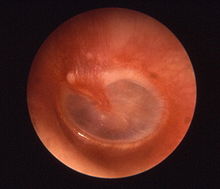Hyperemia

A hyperemia is an excessive blood supply in an organ or tissue , usually caused by vascular dilation. Hyperemia is the opposite of ischemia .
Hyperemia results from irritation. This can occur endogenously as an inflammatory process in the context of an infection or in the case of abnormalities in the blood circulation. An exogenous occurrence is possible through exogenous irritants. For example, hyperemia develops in the skin after an ointment that promotes blood circulation has been applied. This is used, among other things, to arterialize the blood in capillary blood gas analysis .
Reactive hyperemia arises when the maximum blood flow is measured, by congestion of the blood flow with a blood pressure cuff and subsequent reduction of the cuff pressure . Reactive hyperemia can occur after a cold stimulus. In the context of Raynaud's disease , painful hyperemia can often occur.
In pathology , a distinction is made between active and passive hyperemia. Active hyperemia can e.g. B. occur in the context of inflammation due to the release of vasoactive substances (including histamine ) or be of neurogenic origin ( emotions , sport ). Passive hyperemia is the result of a restriction in the flow of blood from a tissue (venous congestion), e.g. B. in the context of heart failure (systemic), liver cirrhosis ( portal ) or thrombosis (local). Persistent passive hyperemia leads to the development of edema .